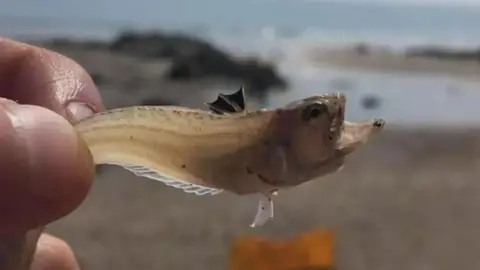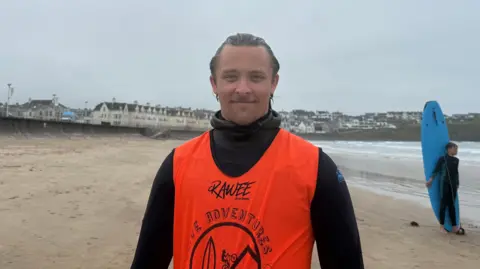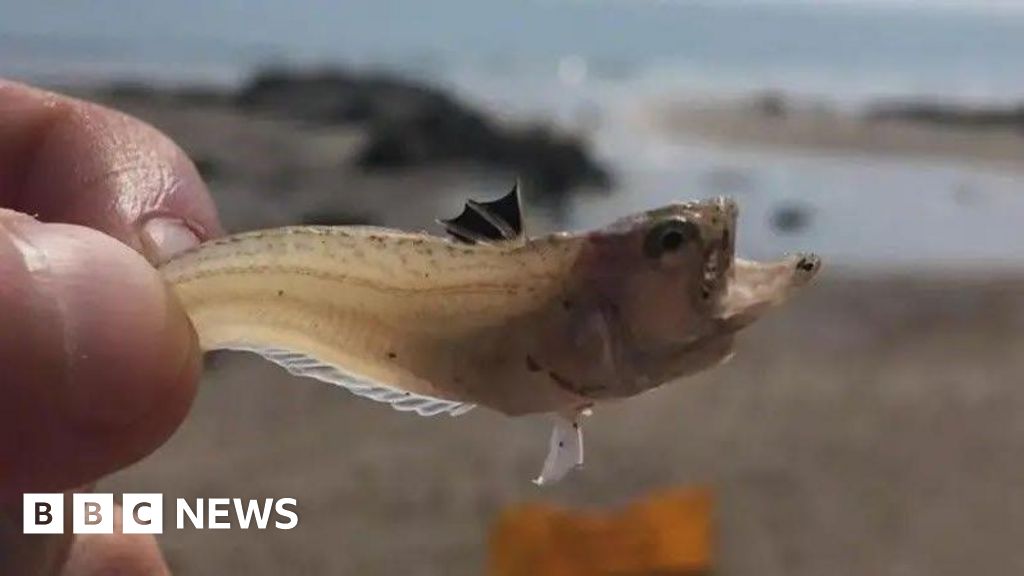 National Coastguard Mablethorpe
National Coastguard Mablethorpe
Weever fish have tiny venomous spines on their dorsal fins, which can deliver a painful sting when stood on
They’re tiny, almost invisible, extremely painful for anyone unfortunate to walk barefoot onto one of their venomous spines – and they’re popping up on beaches in Northern Ireland.
The presence of weever fish on the north coast has led two councils – Mid and East Antrim and Causeway Coast and Glens – to warn beachgoers to watch their step.
The fish spend most of their lives buried in the sand and have venomous spines on their dorsal fins, which can deliver a very sore sting.
They are found all over the UK and are some of the only venomous fish found in local waters – but a local lifeguard said the warmer weather is driving an increase in run-ins with weever fish.
“With more people coming to the beach we’ve had more weever fish stings and a lot of people may not know about them so they might find it hard to identify what they’ve actually been stung by,” said Maria Dillon, an RNLI lifeguard who patrols along Portrush West Strand Beach.
She described the initial feeling of a sting as “like stepping on a sharp shell”.

RNLI lifeguard Maria Dillon said there has been a lot more reports of weever fish stings due to the warmer weather
“This will be followed by a continuous throbbing, maybe swelling, or redness in the foot, this will go on until the sting is submerged in hot water.”
She said if anyone is stung at a lifeguarded beach, they should alert them as “the lifeguard can assist by providing water as hot as they can handle for 20 to 30 minutes”.
“Steps that beachgoers can take to protect themselves may include wetsuit boots or swimming shoes when wading in the shallow waters,” she added.
 Getty Images
Getty Images
Weever fish are about 15cm long with a deep yellowish body so they are hard to spot buried in the sand
The fish are about 15cm long with a deep yellowish body so they are hard to spot buried in the sand.
They are most commonly noticed during June to October.
Mid and East Antrim Borough Council said that while the “number of incidents reported directly to council is low, there may be other incidents that have not been reported”.
“However, due to the pain that weever fish can inflict (and in some case require medical attention if there is an adverse reaction), we felt it prudent to warn members of the public to be vigilant and take precautions.”
What’s the view on weever fish from Portrush?

Eve Curry was stung by a weever fish last year while taking a surfing lesson
Some of the beachgoers who spoke to BBC News NI on Portrush’s West Strand have had some unfortunate first-hand experience with the stinging fish.
Eve Curry was on the receiving end last year while taking a surfing lesson.
“It really, really hurt, it felt like a line of pain through the bottom of my foot,” she said.
“At first I didn’t really notice it because I was in the water, so I thought I was just imagining it but then it got worse and when we started to come out of the water I was like: ‘There’s something wrong, I’ve stepped on something.'”
Eve said her initial thought was it was a jellyfish sting but when she told her surfing instructor they told her that she had stepped on a weever fish.
She was then taken to the lifeguard hut and submerged her foot in hot water for 20 minutes.
Eve said it was “quite sore” but because she noticed it so quickly and did not have to walk far for assistance, she “probably didn’t get the full experience”.
While she didn’t know what a weever fish was before her painful introduction, she has since looked them up and thinks they’re “quite cute in a way”.
A near miss

Norma Rae nearly stepped on a weever fish last year but felt something wriggle under her foot
Norma Rae, who regularly brings her children surfing, said she had heard of an increase in stinging incidents in recent years.
She said she had a near miss in 2024 when she felt something wiggle beneath her foot.
“Literally for a second I set my foot down and something wriggled and I lifted my foot because there’s nothing else really under the sand that’s going to be doing that.”
Ms Rae said it is important to look out for the weever fish as they are “quite hidden” but that it is not going to stop her enjoying the beach.

Jeannette Wilson and David Ewart said they did not know much about weever fish
For others, weever fish are less well known – Jeanette Wilson said she’d never heard of one while David Ewart said he had a “vague recollection” of them but did not know much.
He said he imagined the sting would be “something similar to trying to remove a tick or small barb with tweezers”.
Ms Wilson said the warnings made sure she would “absolutely” keep her guard up and keep in mind what to do about a sting.
‘Particularly bad this year’

Surf instructor Andrzej Krystowski said weever stings have been “particularly bad” this year
Andrzej Krystowski, a surfing instructor, is well used to weever fish sightings.
“We see them all over the coast but this year has been particularly bad,” he told BBC News NI.
“I don’t know what the reason behind it is but we’re seeing a lot more of the black flies so maybe that could be it.
“They’re everywhere all over the north coast, and people often ask me if they walk on a certain area of the beach can they avoid them – but they’re everywhere and you can’t see them.”

